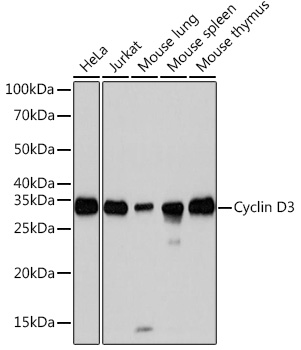Cell Cycle Antibodies 2
Anti-Cyclin D3 Antibody (CAB3989)
- SKU:
- CAB3989
- Product Type:
- Antibody
- Reactivity:
- Human
- Reactivity:
- Mouse
- Reactivity:
- Rat
- Host Species:
- Rabbit
- Isotype:
- IgG
- Research Area:
- Cell Cycle
Description
| Antibody Name: | Anti-Cyclin D3 Antibody |
| Antibody SKU: | CAB3989 |
| Antibody Size: | 20uL, 50uL, 100uL |
| Application: | WB |
| Reactivity: | Human, Mouse, Rat |
| Host Species: | Rabbit |
| Immunogen: | A synthesized peptide derived from human Cyclin D3 |
| Application: | WB |
| Recommended Dilution: | WB 1:500 - 1:2000 |
| Reactivity: | Human, Mouse, Rat |
| Positive Samples: | HeLa, Jurkat, Mouse lung, Mouse spleen, Mouse thymus, Rat lung |
| Immunogen: | A synthesized peptide derived from human Cyclin D3 |
| Purification Method: | Affinity purification |
| Storage Buffer: | Store at -20'C. Avoid freeze / thaw cycles. Buffer: PBS with 0.02% sodium azide, 0.05% BSA, 50% glycerol, pH7.3. |
| Isotype: | IgG |
| Sequence: | Email for sequence |
| Gene ID: | 896 |
| Uniprot: | P30281 |
| Cellular Location: | Cytoplasm, Membrane, Nucleus |
| Calculated MW: | 32kDa |
| Observed MW: | 33KDa |
| Synonyms: | CCND3, cyclin D3 |
| Background: | The protein encoded by this gene belongs to the highly conserved cyclin family, whose members are characterized by a dramatic periodicity in protein abundance through the cell cycle. Cyclins function as regulators of CDK kinases. Different cyclins exhibit distinct expression and degradation patterns which contribute to the temporal coordination of each mitotic event. This cyclin forms a complex with and functions as a regulatory subunit of CDK4 or CDK6, whose activtiy is required for cell cycle G1/S transition. This protein has been shown to interact with and be involved in the phosphorylation of tumor suppressor protein Rb. The CDK4 activity associated with this cyclin was reported to be necessary for cell cycle progression through G2 phase into mitosis after UV radiation. Several transcript variants encoding different isoforms have been found for this gene. [provided by RefSeq, Oct 2008] |
| UniProt Protein Function: | CCND3: Regulatory component of the cyclin D3-CDK4 (DC) complex that phosphorylates and inhibits members of the retinoblastoma (RB) protein family including RB1 and regulates the cell-cycle during G(1)/S transition. Phosphorylation of RB1 allows dissociation of the transcription factor E2F from the RB/E2F complex and the subsequent transcription of E2F target genes which are responsible for the progression through the G(1) phase. Hypophosphorylates RB1 in early G(1) phase. Cyclin D-CDK4 complexes are major integrators of various mitogenenic and antimitogenic signals. Also substrate for SMAD3, phosphorylating SMAD3 in a cell-cycle-dependent manner and repressing its transcriptional activity. Component of the ternary complex, cyclin D3/CDK4/p27Kip1, required for nuclear translocation and activity of the cyclin D-CDK4 complex. Interacts with the CDK4 and CDK6 protein kinases to form a serine/threonine kinase holoenzyme complex. The cyclin subunit imparts substrate specificity to the complex. Interacts with ATF5. Interacts with EIF3K. Component of the ternary complex cyclin D/CDK4/p27Kip1 required for nuclear translocation and modulation of CDK4-mediated kinase activity. Can form similar complexes with either p21Cip1 or CDKN2A. Belongs to the cyclin family. Cyclin D subfamily. 2 isoforms of the human protein are produced by alternative splicing. |
| UniProt Protein Details: | Protein type:Nuclear receptor co-regulator; Cell cycle regulation; Activator Chromosomal Location of Human Ortholog: 6p21 Cellular Component: cyclin-dependent protein kinase holoenzyme complex; cytoplasm; focal adhesion; nucleoplasm; plasma membrane Molecular Function:protein binding; protein kinase binding Biological Process: positive regulation of cyclin-dependent protein kinase activity; positive regulation of protein amino acid phosphorylation |
| NCBI Summary: | The protein encoded by this gene belongs to the highly conserved cyclin family, whose members are characterized by a dramatic periodicity in protein abundance through the cell cycle. Cyclins function as regulators of CDK kinases. Different cyclins exhibit distinct expression and degradation patterns which contribute to the temporal coordination of each mitotic event. This cyclin forms a complex with and functions as a regulatory subunit of CDK4 or CDK6, whose activtiy is required for cell cycle G1/S transition. This protein has been shown to interact with and be involved in the phosphorylation of tumor suppressor protein Rb. The CDK4 activity associated with this cyclin was reported to be necessary for cell cycle progression through G2 phase into mitosis after UV radiation. Several transcript variants encoding different isoforms have been found for this gene. [provided by RefSeq, Oct 2008] |
| UniProt Code: | P30281 |
| NCBI GenInfo Identifier: | 20981685 |
| NCBI Gene ID: | 896 |
| NCBI Accession: | P30281.2 |
| UniProt Secondary Accession: | P30281,Q5T8J0, Q6FG62, Q96F49, B2RD63, B3KQ22, E9PAS4 E9PB36, |
| UniProt Related Accession: | P30281 |
| Molecular Weight: | 9,736 Da |
| NCBI Full Name: | G1/S-specific cyclin-D3 |
| NCBI Synonym Full Names: | cyclin D3 |
| NCBI Official Symbol: | CCND3 |
| NCBI Protein Information: | G1/S-specific cyclin-D3 |
| UniProt Protein Name: | G1/S-specific cyclin-D3 |
| Protein Family: | G1/S-specific cyclin |
| UniProt Gene Name: | CCND3 |
| UniProt Entry Name: | CCND3_HUMAN |
View AllClose




![Anti-Cyclin D3 Antibody (CAB0746)[KO Validated] Anti-Cyclin D3 Antibody (CAB0746)[KO Validated]](https://cdn11.bigcommerce.com/s-rd6ounxcu2/images/stencil/590x590/products/38267/43013/anti-cyclin-d3-antibody-cab0746ko-validated__46456__22302.1706520812.jpg?c=1)


